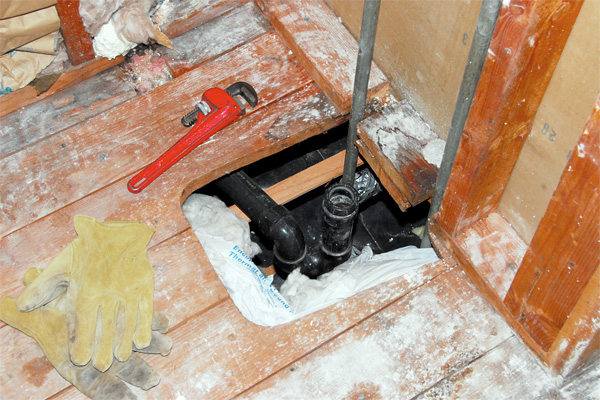
There’s a gap in your home that’s wasting precious energy and inviting cold air inside — do you know where it is?
Have you caulked windows and replaced weather stripping on your doors? Good for you. But if you think you’ve sealed up air leaks, you’re in for a shock.
The biggest air leak in your home is right under your nose.
Or, underfoot, more accurately.
It’s the hole that a plumber cuts in the subfloor to make room for the drain assembly at the bottom of a bathtub. Because the drain assembly is big, plumbers make way for it by cutting a generous-size hole that gives them some “wiggle room” when connecting plumbing pipes. This big hole often is left open to the space below.
How You Know If You Have This Bathtub HoleIf you have a first-floor bathroom over a crawl space or unheated basement, you likely have one of these giant energy wasters in your home.
“Having that big hole for the bathtub drain can waste about as much energy as leaving one of your windows open a few inches, all day, every day,” says Allison Bailes III, president of energy consultant firm Energy Vanguard. “The main difference is that you can easily close the window, but most people don’t even know about this other open window.”
And BTW, that hole also is big enough for good-size critters to crawl inside your home!
Best Way to Plug the Leak
Plumbers may plug this hole with a wad of loose insulation, but that’s an imperfect solution — fiberglass insulation can sag over time, especially if it gets damp. The preferred method:
1. Crawl under your bathroom to look at the drain assembly from underneath.
2. Patch the hole with pieces of foam board that’s cut to fit around the pipes. Screw them in place.
3. Then seal any gaps with spray foam insulation ($8/can).
A plumber will do the job, too, but that’ll set you back $100-$150. Probably worth it when you think about energy savings, comfort, and keeping mice and camel crickets out of your house.
Or, underfoot, more accurately.
It’s the hole that a plumber cuts in the subfloor to make room for the drain assembly at the bottom of a bathtub. Because the drain assembly is big, plumbers make way for it by cutting a generous-size hole that gives them some “wiggle room” when connecting plumbing pipes. This big hole often is left open to the space below.
How You Know If You Have This Bathtub HoleIf you have a first-floor bathroom over a crawl space or unheated basement, you likely have one of these giant energy wasters in your home.
“Having that big hole for the bathtub drain can waste about as much energy as leaving one of your windows open a few inches, all day, every day,” says Allison Bailes III, president of energy consultant firm Energy Vanguard. “The main difference is that you can easily close the window, but most people don’t even know about this other open window.”
And BTW, that hole also is big enough for good-size critters to crawl inside your home!
Best Way to Plug the Leak
Plumbers may plug this hole with a wad of loose insulation, but that’s an imperfect solution — fiberglass insulation can sag over time, especially if it gets damp. The preferred method:
1. Crawl under your bathroom to look at the drain assembly from underneath.
2. Patch the hole with pieces of foam board that’s cut to fit around the pipes. Screw them in place.
3. Then seal any gaps with spray foam insulation ($8/can).
A plumber will do the job, too, but that’ll set you back $100-$150. Probably worth it when you think about energy savings, comfort, and keeping mice and camel crickets out of your house.
Read more: http://www.houselogic.com/home-advice/insulation/biggest-air-leak-home/#ixzz2pGq57UYz
No comments:
Post a Comment